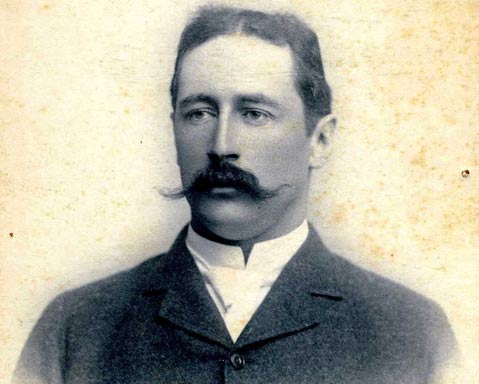Who Was Richard Hall?
S.B.'s First Director of Cottage Hospital

In the 1870s, Santa Barbara began to develop a national reputation as a health resort. Yet, ironically, the city did not have a hospital. This changed in December 1891 with the opening of Cottage Hospital. The first director of the hospital’s surgical department was a transplant from New York, Dr. Richard Hall, who had overcome incredible obstacles in getting to Santa Barbara.
Hall was a native of Ireland and immigrated to New York City with his family at age 12. His father was the Reverend John Hall, who became one of the foremost clergymen in the U.S.
Richard Hall entered Princeton University in 1871 when he was 15, and graduated before he was out of his teens. He then began medical training at the New York College of Physicians and Surgeons, where he posted an outstanding record. He received his medical degree in 1878 at the age of 22 and began his residency at Roosevelt Hospital in New York City. Within a year, he was appointed house surgeon at the hospital.
In 1879, Hall took Elizabeth Boyes Coolidge as his bride. She was a member of one of the most prominent families in Boston; her cousin, Calvin Coolidge, later became president of the United States. The couple spent about a year traveling through Europe as the young doctor studied procedures at the major medical centers. In autumn 1880, the 24-year-old surgeon returned to New York and took up appointments at the New York College of Physicians and Surgeons and at Roosevelt Hospital. It appeared he was embarking upon a career of virtually unlimited potential.
For instance, in 1886, Hall performed the first successful appendectomy in this country. Before this time, the treatment of acute appendicitis was problematic at best. Hall’s operation truly was a milestone in internal medicine. What makes this breakthrough even more remarkable was that Hall was a drug addict when he performed his groundbreaking feat.
In 1884, Hall and his close friend and colleague, William Halsted, had become interested in the use of cocaine as an anesthesia. They began using themselves as subjects in experiments to determine the proper dosage for local and regional anesthesia. In one experiment, Hall submitted to dental work while under the drug. It was not long before both surgeons became addicted to the narcotic. Halsted ended up receiving hospital treatment and went on to a highly distinguished surgical career.
Hall moved to the West Coast in an attempt to escape the drug’s clutches. The Halls were acquainted with the Rowland Hazard family of Mission Canyon and decided to relocate to Santa Barbara late in 1889. After several self-described “ups and downs,” Hall managed to free himself from his addiction. In any case, the move from the metropolis of New York City to the small town of Santa Barbara must have been quite an adjustment.
Hall opened a practice on Garden Street with Dr. G. Walther Otto and both men lectured and practiced at Cottage Hospital. The two were also instrumental in founding the Santa Barbara County Medical Society in 1894. Hall became chief surgeon at Cottage, and the hospital became one of the primary surgical centers in the state.
In October 1896, Hall created quite a stir when he introduced an x-ray machine to the hospital, which had been invented just a year before, once again demonstrating his interest in innovation. Hall gave a public demonstration of the machine with proceeds going to the Cottage Children’s Ward. People were amazed to see “the strange spectacle of one’s flesh melting away, exhibiting the naked bones of the hand or arm.” Both Hall and his wife got involved in a number of community activities.
At the end of 1896, Hall began experiencing abdominal pain-diagnosis appendicitis. In a cruel twist of fate, the man who had performed the first appendectomy in the U.S. died of a ruptured appendix on January 24, 1897.
The entire city mourned his passing. A close friend, Anna Cabot Blake, founder of the school that would eventually become UC Santa Barbara, gave $10,000 to endow the Richard Hall Bed at Cottage. It was a fitting tribute to this man of medicine.



